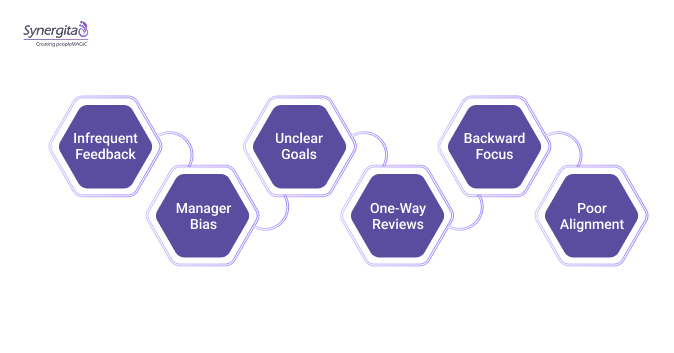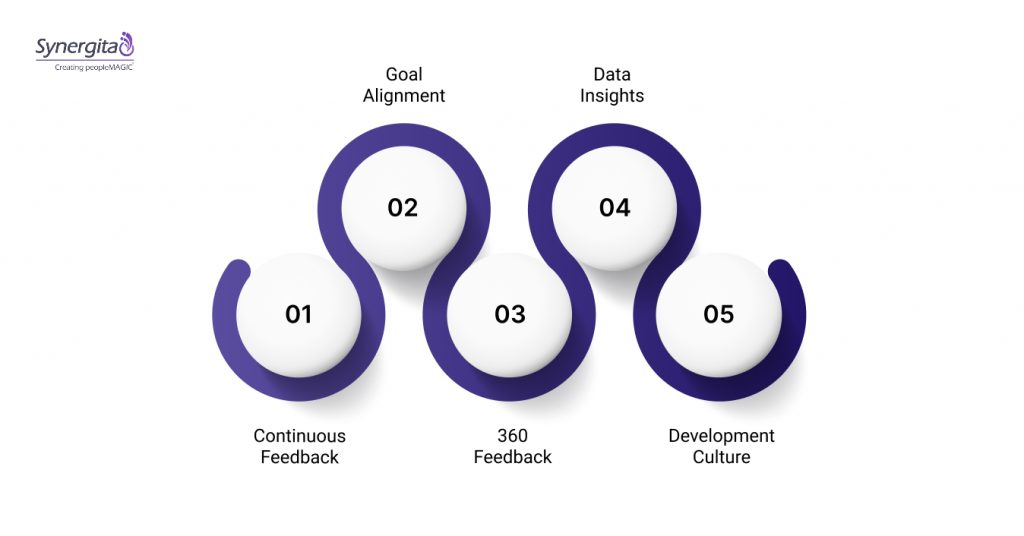Deadlines slip, achievements go unnoticed, and employees wonder if their efforts even matter; a reality for many organizations, with 75% unable to accurately assess individual contributions. Annual performance reviews can not keep up with today’s fast-moving, hybrid work environments.
The solution lies in continuous, real-time appraisals that convert feedback into actionable steps. By tracking goals, sharing timely insights, and aligning individual efforts with organizational priorities, reviews become a tool for growth rather than a bureaucratic formality.
This blog guides you through the best practices for performance appraisals in 2025, helping you make every evaluation meaningful and impactful.
Key Takeaways:
- Problem: Traditional annual reviews are often delayed, biased, and misaligned with organizational goals; only 6% of organizations effectively utilize data.
- Solution: Modern appraisals focus on continuous feedback, goal alignment, data-driven insights, and development-focused conversations.
- Best Practices: Weekly/bi-weekly check-ins, SMART & cascading OKRs, 360-degree feedback, analytics, and growth-oriented coaching.
- Case Studies: Google, Meta, and TikTok show how real-time feedback, transparent rewards, and candid conversations improve engagement and performance.
- Challenges: resistance, inconsistent adoption, unclear goals, tool integration, feedback fatigue, and measuring impact, which can be managed with training, clear communication, and proper tools.
- Tool: Synergita turns performance appraisals into actionable growth, aligning goals, feedback, and insights for 350,000+ users.
The Problem with Traditional Reviews
Performance reviews once held teams accountable, but as work moves faster and becomes more hybrid, that old model is showing its cracks. Delayed, formal feedback often demotivates rather than develops, turning reviews into a chore instead of a growth opportunity.
The gap between performance and perception continues to widen. Only 6% of organizations effectively use data and evidence to improve performance management and build worker trust (Deloitte). Most still rely on outdated methods that overlook context, undervalue contribution, and leave employees unsure where they stand.
Here are the biggest problems traditional reviews bring:

- Infrequent Feedback – Long gaps between reviews delay course correction, letting small issues pile up.
- Manager Bias – Ratings often hinge on perception, not data, leading to inconsistency and unfairness.
- Unclear Goals – Vague objectives leave employees unsure what success looks like.
- One-Way Reviews – Feedback flows top-down, with little room for employee input or dialogue.
- Backward Focus – Annual reviews often dwell on past mistakes, creating anxiety rather than motivation.
- Poor Alignment – Infrequent and subjective reviews often fail to reflect company-wide priorities accurately.
After seeing the pitfalls of traditional reviews, explore the most common performance appraisal mistakes and learn how to fix them.
With these significant issues in mind, it’s clear that traditional appraisals are becoming more of a liability than a benefit in modern workplaces. The good news is: there are proven best practices that address these problems head-on.
Best Practices for Performance Appraisals

Modern performance appraisals go beyond annual checkboxes. In 2025, they focus on continuous feedback, real-time growth, and measurable impact. The goal is to develop employees, build engagement, and align performance with organizational objectives.
Below are the best practices guiding effective performance reviews today.
1. Shift to Continuous Feedback Loops
Continuous feedback means replacing infrequent, formal reviews with ongoing, short conversations about progress, challenges, and opportunities. Rather than waiting months to discuss performance, managers and employees engage regularly to course-correct and reinforce good work.
Key Benefits:
- Higher engagement: Gallup data shows 80% of employees who received meaningful feedback in the past week are fully engaged.
- Timely improvements: Problems are spotted early, before they escalate.
- Better alignment: Conversations keep goals top of mind and help adjust priorities in real time.
- Reduced turnover: Organizations that use regular feedback report lower attrition rates.
Quick Implementation Tip
Start with weekly or bi-weekly 1:1s focused on one or two goals. Use a simple feedback template: what’s going well, what’s blocking, what to try next.
2. Align Individual Goals with Organizational Objectives
Goal alignment ensures that individual efforts feed into the company’s larger mission. Techniques like cascading OKRs and SMART goals help translate high-level strategies into day-to-day priorities.
Key Benefits
- Clarity of purpose: Everyone knows how their work contributes to business results.
- Motivation increases: When employees see the bigger picture, they feel more invested.
- Better measurement: Clear, measurable goals reduce ambiguity in performance assessment.
Quick Implementation Tip
Define 2 to 3 top company OKRs first. Then cascade them into team and individual objectives. Make every goal SMART (Specific, Measurable, Achievable, Relevant, Time-bound).
3. Incorporate 360-Degree Feedback
360-degree feedback,like withSynergita, incorporates perspectives from peers, subordinates, supervisors, and managers, not just a single manager. This helps capture blind spots and provides a more comprehensive picture of performance in collaborative environments.
Key Benefits
- Holistic insight: You gain insight into how behaviors are perceived across various roles.
- Improved self-awareness: Employees receive feedback beyond what their boss observes.
- Stronger teamwork: Knowing peer and cross-functional perceptions improves collaboration.
- Leadership growth: It’s especially effective for developing managers and future leaders.
Quick Implementation Tip
Limit the number of raters (e.g., 4 to 6) to keep feedback meaningful and manageable. Use anonymity and align competencies with business priorities. Train reviewers on giving constructive feedback.
4. Utilize Data-Driven Insights
Data-driven appraisal means basing evaluations on measurable metrics, trends, and feedback, rather than relying solely on intuition. Analytics reveal patterns over time, highlight performance trajectories, and guard against bias.
Key Benefits
- Objectivity: Reduces subjectivity in judgments.
- Trend spotting: You can detect declines or improvements across periods.
- Fairer decisions: Evidence-backed feedback is easier to justify and trust.
- Scalable review process: Metrics help scale performance management across teams.
Quick Implementation Tip
Identify 3 to 5 core performance metrics (productivity, quality, goal completions). Use a dashboard to monitor trends and compare qualitative feedback with quantitative scores.
5. Create a Culture of Development
The goal of appraisals should be to develop talent, not merely evaluate it. Emphasizing growth, learning, and coaching ensures that the appraisal process becomes a catalyst for progress, rather than a dreaded ritual.
Key Benefits
- Growth mindset: Employees see feedback as an opportunity, not judgment.
- Retention boost: Development-focused cultures retain talent.
- Continuous improvement: Feedback loops lead to steady evolution.
- Stronger relationships: Coaching builds trust between managers and team members.
Quick Implementation Tip
After each review, co-create a development plan: 2 to 3 actionable goals for improvement. Schedule follow-ups to hold accountability and iterate.
Ready to turn these best practices into results? Synergita makes setting, tracking, and achieving goals effortless, driving 58% faster growth for aligned teams.
To see these best practices in action, let’s explore real-world case studies showing how companies have transformed performance appraisals to boost engagement, alignment, and results.
Case Studies: Companies Leading the Way
Even with best practices in place, many organizations struggle to implement them effectively. These case studies demonstrate how top companies have addressed common appraisal challenges, including transforming feedback into actionable growth and aligning rewards with real impact, where performance management drives results.
1. Google
Google updated its employee appraisal program to increase transparency and fairness. The company now links rewards, such as bonuses and equity, more directly to performance, ensuring that top contributors are recognized promptly. This approach encourages accountability, motivates employees, and strengthens the connection between individual impact and organizational success.
2. Meta
Meta recently approved bonuses for roughly 200 employees across the company, demonstrating a strong link between performance and rewards. By directly tying compensation to measurable achievements, Meta reinforces a results-driven culture where contributions are recognized and employees are motivated to deliver high-impact work.
3. TikTok
TikTok advises managers to prioritize honest, direct feedback over “niceness” during performance reviews. By encouraging candid conversations, the company allows for a high-performance culture where employees receive actionable insights, clearly understand expectations, and can continually improve.
These examples demonstrate success in action, but implementing modern appraisals still presents its own set of challenges.
Modern Performance Appraisal Challenges
Modern performance appraisals go beyond annual reviews, emphasizing continuous feedback, goal alignment, and data-driven insights. Yet, moving from traditional systems can be challenging; managers may resist, employees may adopt inconsistently, and tools may not integrate smoothly.
The table below highlights common challenges and practical workarounds.
| Challenge | Workaround / Solution |
|---|---|
| Resistance from Managers | Provide training on continuous feedback and link team outcomes to the benefits they achieve. |
| Inconsistent Employee Adoption | Start with pilot teams, communicate expectations clearly, and celebrate early wins. |
| Lack of Goal Clarity | Use SMART goals or cascading OKRs to align individual objectives with organizational priorities. |
| Tool Integration Issues | Select platforms that integrate with your existing HRIS, collaboration, and productivity tools. |
| Feedback Fatigue | Balance regular check-ins with concise, actionable feedback to avoid overload. |
| Measuring Impact | Leverage analytics dashboards and data-driven metrics to track performance trends and outcomes. |
To overcome these appraisal challenges, organizations require a tool that aligns goals, tracks progress, and facilitates continuous feedback.
Picking the Right Performance Management Tool
Modern performance management is not just about tracking tasks; it’s about connecting every employee’s contributions to broader organizational goals. The right platform bridges that gap by enabling continuous feedback, aligning goals, and providing actionable insights.
Managers gain clear visibility into team progress, employees understand expectations, and organizational objectives stay central. Smooth integration with existing workflows ensures consistent and effortless adoption across teams.
Synergita embodies this approach, supporting over 350,000 users and tracking more than 6 million goals across organizations. With centralized OKRs, real-time feedback, customizable workflows, and interactive dashboards, it transforms performance appraisals into a growth-focused, engaging, and transparent process. Keep your teams aligned, motivated, and performing at their best.
Book a demo todayto see it in action!
FAQs
1. What are performance appraisals?
Performance appraisals are structured evaluations of an employee’s work, skills, and contributions, used to guide growth, development, and compensation decisions.
2. Why are traditional annual reviews ineffective?
Annual reviews often provide delayed feedback, risk bias, and a focus on past performance, and frequently fail to align individual efforts with organizational goals.
3. What are performance appraisal best practices?
Performance appraisal best practices are structured methods and strategies that ensure employee evaluations are fair, actionable, and aligned with organizational goals.
4. What is 360-degree feedback, and how does it support performance appraisal?
360-degree feedback gathers input from peers, subordinates, and supervisors, providing a comprehensive view that promotes fairness and identifies areas for growth.
5. How can I implement modern performance appraisal best practices?
Use a platform that tracks goals, feedback, and performance. Synergita centralizes these, making appraisals transparent, actionable, and growth-focused.



